Evaluation Method of Relative Humidity Changes in Below-Grade Concrete Structure Space Depending on Different Waterproofing Material and Installation Method
Abstract
1. Introduction
1.1. Structural Degradation Problems Due to Increase in RH in Concrete Structures
1.1.1. Reinforcing Steel Corrosion and Freeze Thaw
1.1.2. Spalling due to Pressurized Moisture in Concrete Due to Increase of Temperature (Fire Hazard)
1.2. Mold Growth, Discomfort, and Radon Due to Increase in RH
1.2.1. Mold Growth Due to Increase of RH
1.2.2. Discomfort Due to Increase of RH
1.2.3. Health Related Issues Due to RH
2. Protection and Evaluation Methods
2.1. Waterproofing in Negative and Positive Side on Underground Structures
2.1.1. Waterproofing Materials Commonly used in Positive Side Waterproofing
2.1.2. Waterproofing Materials Commonly used in Negative Side Waterproofing
2.2. Proposal of Evaluation Criteria Based on Risk Factors Due to High RH in Concrete Structures
3. Proposed Evaluation Method for RH Control Performance of Waterproofing Materials
3.1. Experimental Equipment
3.2. Specimen Assembly for Evaluation
3.2.1. Waterproofing Specimen
3.2.2. Acrylic Apparatus Assembly of Waterproofing Specimens for RH Measurement
3.3. Test Condition Setting for Estimation of Humidity Change Performance of Waterproofing Materials
3.4. Data Collection for the Acrylic Apparatus
3.4.1. Humidity Level Changes of Waterproofing Membrane Installation Methods
3.4.2. Parameter Analysis (Average, Slope Intercept, and Maximum) Measured RH and Comparison
3.4.3. Probability Density Analysis of Measured RH
4. Conclusions
- (1)
- that waterproofing material (type and existence of) impacts humidity in the negative side of the concrete structure across different seasonal conditions;
- (2)
- an evaluation of the average, intercept and maximum RH, slope, and the RH variance range can be used to compare the different waterproofing methods and materials’ humidity control performance
- (3)
- the study results provide an insight on how easy future humidity control would be given a waterproofing material.
Author Contributions
Acknowledgments
Conflicts of Interest
Abbreviations
| ASTM | American Standards for Testing and Materials |
| BS EN | British Standard European |
| GB | Guobiao |
| KS | Korean Industrial Standards |
| LH | KOREA LAND & HOUSING CORPORATION |
| RH | Relative Humidity |
References
- An, K.W.; Lee, Y.S.; Lee, J.H.; Song, J.Y.; Oh, S.K. Humidity Change Rate Analysis for Various Waterproofing Method in Underground Structures During Winter Season. J. Korea Inst. Struct. Maint. Insp. 2016, 20, 118–125. [Google Scholar]
- Chang, S.M.; Oh, S.K.; Seo, D.S.; Choi, S.M. Characteristics of Humidity-Temperature Changing in the Below-Grade Concrete Structure by Applying Waterproofing Materials on the Exterior Wall. Adv. Build. Technol. Constr. Mater. 2015, 2015. [Google Scholar] [CrossRef]
- Ismail, M.; Egba, E.I. Effects of climate and corrosion on concrete behavior. AIP Conf. Proc. 2017, 1903, 020027. [Google Scholar] [CrossRef]
- IAQ. Moisture Control Guidance for Building Design, Construction and Maintenance, Printable Version; Createspace Independent Publishing Platform: Scotts Valley, CA, USA, 2014. [Google Scholar]
- Zhu, F.Z.; Ma, Z.M.; Zhao, T.J. Influence of Freeze-Thaw Damage on the Steel Corrosion and Bond-Slip Behavior in the Reinforced Concrete. Adv. Build. Technol. Constr. Mater. 2016, 2016. [Google Scholar] [CrossRef]
- An, K.W.; Kim, D.B.; Huh, N.H.; Park, J.S.; Oh, S.K. A Study on Humidity Difference between Particular Temperature Environment and Waterproofing Methods to Underground Structures; Korea Scholar: Seoul, Korea, 2014; pp. 779–782. [Google Scholar]
- Francis, R. Humidity and Dew Point: Their Effect on Corrosion and Coatings. In Proceedings of the ACA Annual Conference Proceedings, Victoria, Australia, 13 January 2020; Available online: https://www.academia.edu/17021842/Humidity_and_Dew_Point_Their_Effect_on_Corrosion_and_Coatings (accessed on 1 February 2020).
- Yang, J.; Peng, G.-F.; Shui, G.; Zhang, G. Mechanical Properties and Anti-Spalling Behavior of Ultra-High Performance Concrete with Recycled and Industrial Steel Fibers. Materials 2019, 12, 783. [Google Scholar] [CrossRef] [PubMed]
- Seitllari, A.; Naser, M.Z. Leveraging artificial intelligence to assess explosive spalling in fire-exposed RC columns. Comput. Concr. 2019, 24, 271–282. [Google Scholar] [CrossRef]
- Shah, A.H.; Sharma, U.K. Fire resistance and spalling performance of confined concrete columns. Constr. Build. Mater. 2017, 156, 161–174. [Google Scholar] [CrossRef]
- Jansson, R. Fire Spalling of Concrete: Theoretical and Experiment Studies. Ph.D. Thesis, KTH Royal Institute of Technology, Stockholm, Sweden, 2013. [Google Scholar]
- Public Works Department of Malaysia. Guidelines on the Prevention of Mould Growth in Buildings; Public Works Department of Malaysia: Kuala Lumpur, Malaysia, 2009.
- Zuzana, R.; Ryparová, P. The Dependence of Mold on the Relative Humidity in Different Types of Materials. In Key Engineering Materials; Trans Tech Publications, Ltd.: Zürich, Switzerland, 2017; Volume 731, pp. 98–102. [Google Scholar] [CrossRef]
- Jareemit, D.; Shu, S.; Heidarinejad, M.; Kim, Y.S.; Liu, J.; Alhafi, Z.A.; Srebric, J. Evaluation of Indoor Mold Growth Relative to Indoor Humidity Using a Multi-zone Modeling. 2013. Available online: https://www.researchgate.net/profile/Mohammad_Heidarinejad/publication/266375006_Evaluation_of_Indoor_Mold_Growth_Relative_to_Indoor_Humidity_Using_a_Multi-zone_Modeling/links/5432dd140cf22395f29d035c/Evaluation-of-Indoor-Mold-Growth-Relative-to-Indoor-Humidity-Using-a-Multi-zone-Modeling.pdf (accessed on 17 December 2019).
- Pernilla, J.; Svensson, T.; Annika, E.-T. Critical moisture conditions for mould growth on building materials. Build. Environ. 2013, 62, 201–209. [Google Scholar] [CrossRef]
- American Society of Heating, Refrigerating, and Air-Conditioning Engineers, Inc. Thermal Environmental Conditions for Human Occupancy; American Society of Heating, Refrigerating, and Air-Conditioning Engineers: Atlanta, GA, USA, 2010. [Google Scholar]
- ASHRAE. Moisture Control Guidance for Building Design, Construction and Maintenance; ASHRAE: Atlanta, GA, USA, 2016; ISBN 9781939200426. [Google Scholar]
- Groves-Kirkby, C.J.; Crockett, R.; Denman, A.R.; Phillips, P.S. Climatic and seasonal influences on radon time series in an environment of low anthropogenic activity. In Proceedings of the 13th International Congress of the International Radiation Protection Association (IRPA13), Glasgow, UK, 13–18 May 2012; Available online: http://www.irpa.net/members/P10.74FP.pdf (accessed on 13 January 2020).
- U.S. Department of the Interior/U.S. Geological Survey. The Geology of Radon; U.S. Government Printing Office: Washington, DC, USA, 1992.
- Fernandez-Cortes, A.; Benavente, D.; Cuezva, S.; Cañaveras, J.C.; Alvarez-Gallego, M.; Garcia-Anton, E.; Soler, V.; Sanchez-Moral, M. Effect of Water Vapour Condensation on the Radon Content in Subsurface Air in a Hypogeal Inactive-Volcanic Environment in Galdar Cave, Spain; Atmospheric Environment; Elsevier: Amsterdam, The Netherlands, 2013; Volume 75, pp. 15–23.
- Turk, B.; Hughes, J.; Center, S.R. Exploratory Study of Basement Moisture During Operation of ASD Radon Control Systems; US Environmental Protection Agency Indoor Environments Division: Washington, DC, USA, 2008.
- BSI. BS 8102:2009 Code of Practice for Protection of Below Ground Structures against Water from the Ground; BSI: London, UK, 2009. [Google Scholar]
- ASTM D7832/D7832M-14. Standard Guide for Performance Attributes of Waterproofing Membranes Applied to Below-Grade Walls/Vertical Surfaces (Enclosing Interior Spaces); ASTM International: West Conshohocken, PA, USA, 2014. [Google Scholar]
- The 3rd Research Institute of Engineering Corps—General Staff of PLA. Technical Code for Waterproofing of Underground Works (GB 50108-2008), Approved by Ministry of Housing and Urban-Rural Development of China; The 3rd Research Institute of Engineering Corps—General Staff of PLA: Beijing, China, 2008.
- Song, J.Y.; Oh, K.H.; Kim, B.I.; Oh, S.K. Performance Evaluation of Waterproofing Membrane Systems Subject to the Concrete Joint Load Behavior of Below-Grade Concrete Structures. Appl. Sci. 2017, 7, 1147. [Google Scholar] [CrossRef]
- Jang, S.M.; Choi, S.M.; Lee, J.H.; An, K.W.; Oh, S.K. A Study on the Characteristics of Temperature-Humidity by the Location of Waterproofing Layer with the Concrete Wall as the Center in the Basement; Korea Concrete Institute: Korea, Seoul, 2013; Volume 10, pp. 31–32. [Google Scholar]
- Deckard, C.; Hagerty, P.D. Rethinking Waterproofing for Subsurface Structures. In Forensic Engineering 2009: Pathology of the Built Environment, 1st ed.; Chen, S.-E., de Leon, A.D., Dolhon, A.M., Drerup, M.J., Parfitt, M.K., Eds.; American Society of Civil Engineers (ASCE): Washington, DC, USA, 2009; pp. 298–307. [Google Scholar]
- Oh, S.K.; Shim, J.S. Maintenance for Leakage due to Cracking in Concrete Structures-Guidelines for Repair of Water-Leakage Cracks in Concrete Structures. J. Korea Concr. Inst. 2011, 23, 47–52. [Google Scholar]
- An, K.W.; Kang, H.J.; Oh, K.H.; Kim, S.Y.; Oh, S.K. A Study on the Environmental Degradation Factors and the Required Performance of the Waterproofing Materials Applied to Underground Structures in Residential Apartment Buildings. Korea Inst. Build. Constr. 2017, 17, 213–214. [Google Scholar]
- An, K.W.; Kang, H.J.; Kim, S.Y.; Oh, S.K. An analysis of the Factors Influencing Leakage of Below-Grade Concrete Structures in Residential Buildings-Survey Centered Data. Korea Inst. Build. Constr. 2017, 17, 73–74. [Google Scholar]
- Korea Land & Housing Corporation. Establishment of Measures to Improve Quality of House Waterproofing Methods for Zero Defects in Quality Management; Public Housing Project Office: Gyeongnam, Korea, 2017; p. 3. [Google Scholar]
- Korea Meteorological Administration. 2012 Monthly Weather Report; 2012. Available online: http://www.kma.go.kr/eng/weather/forecast/currentkorea.jsp (accessed on 16 December 2019).
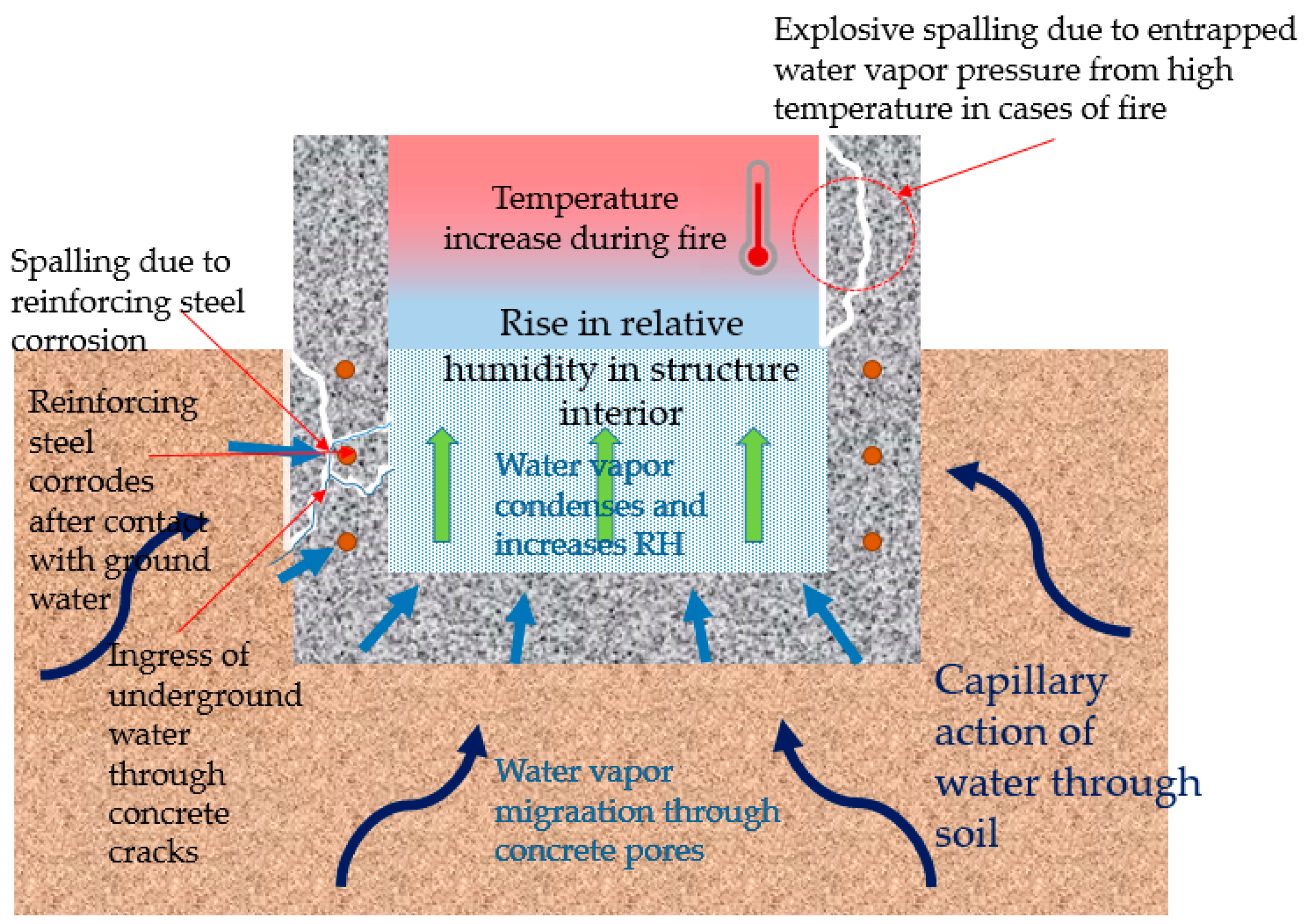
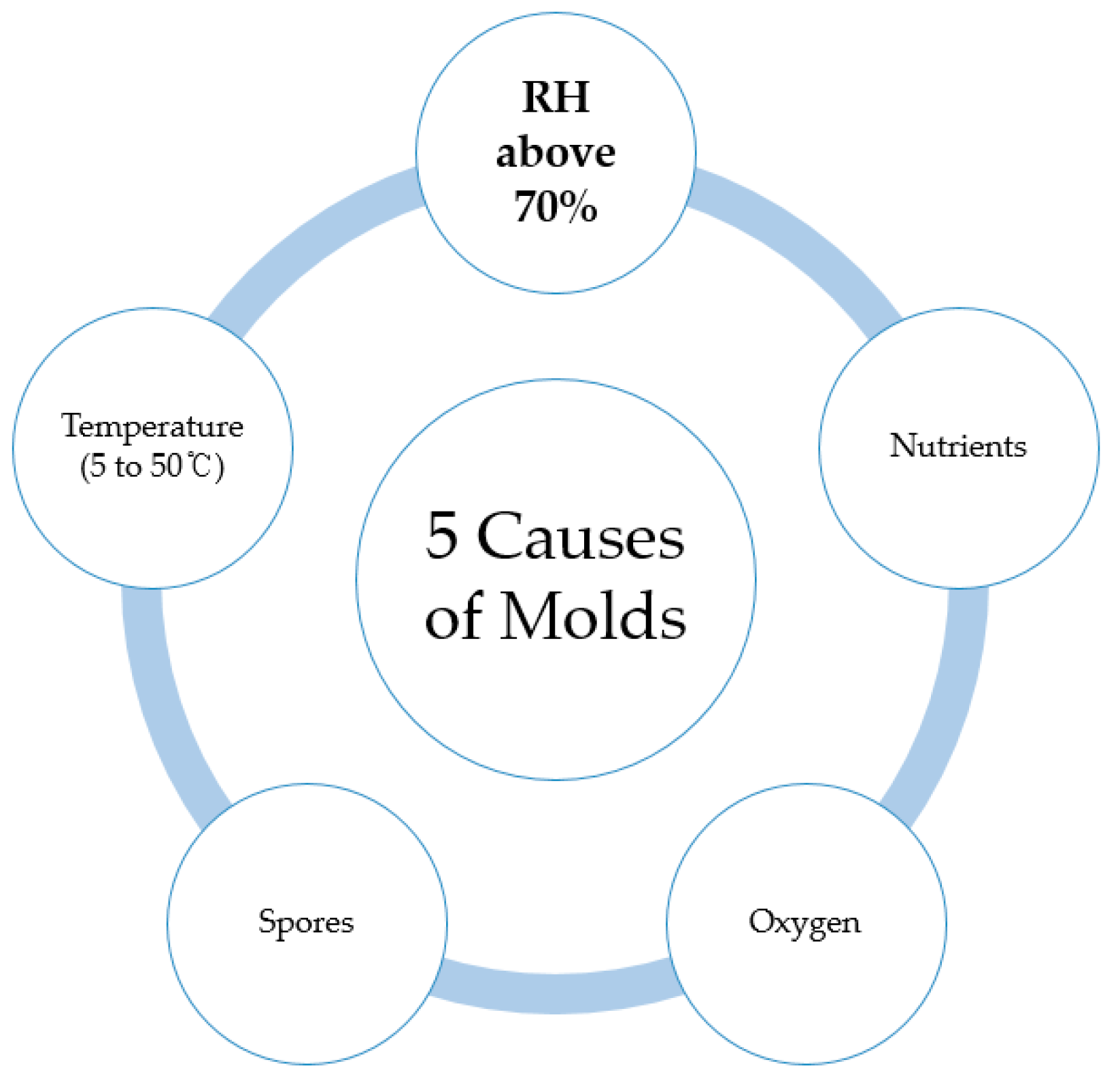

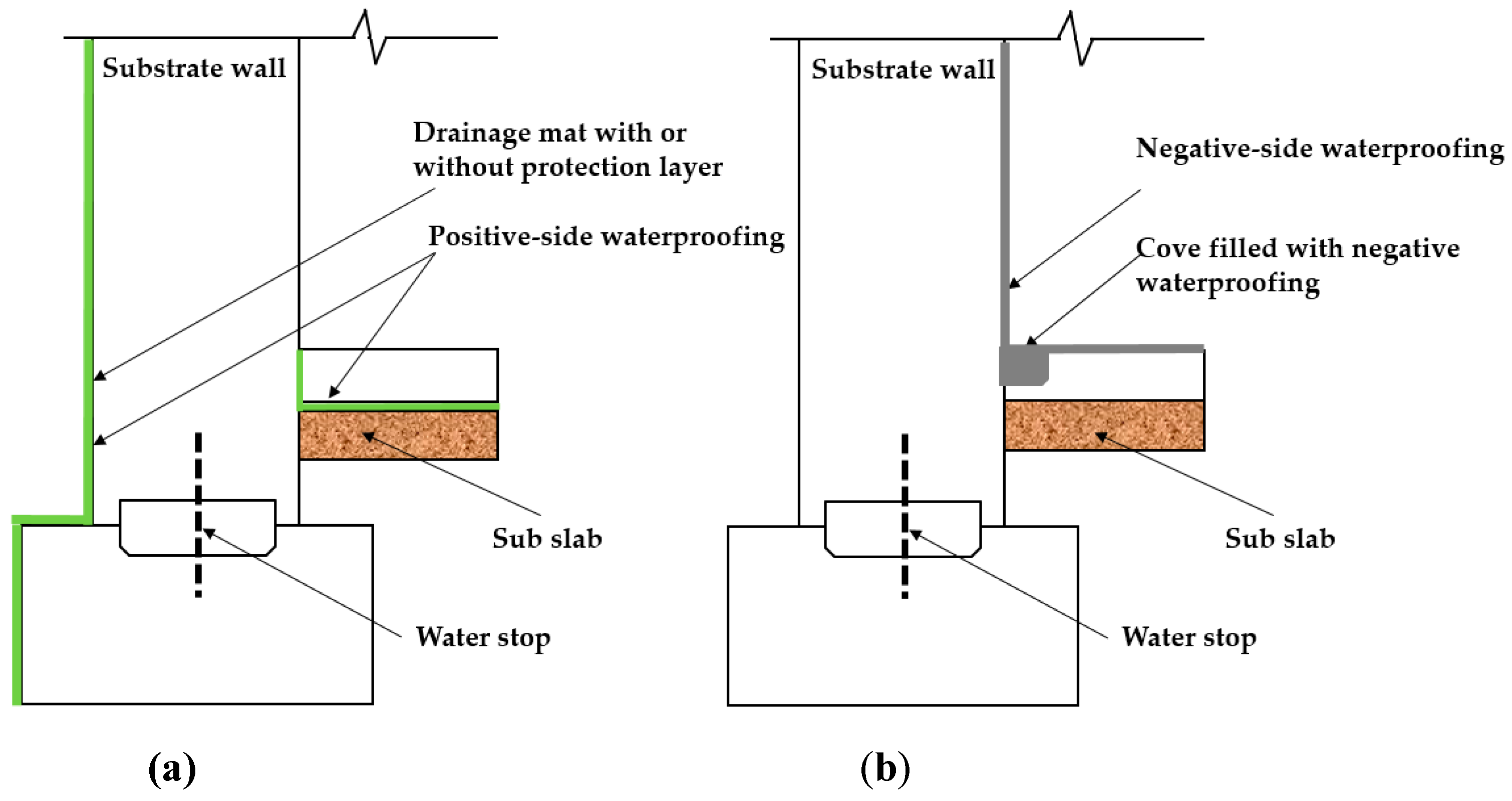
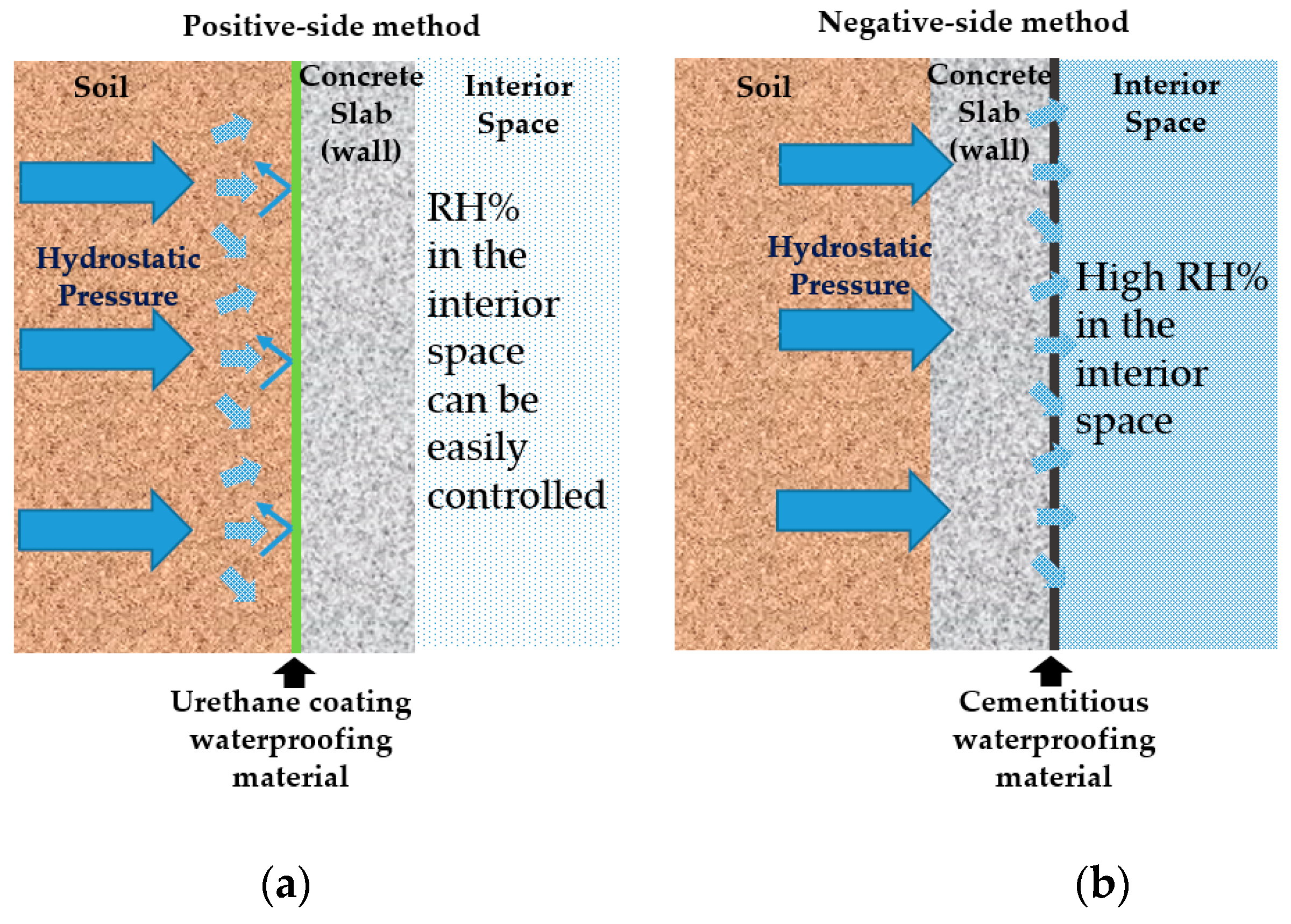

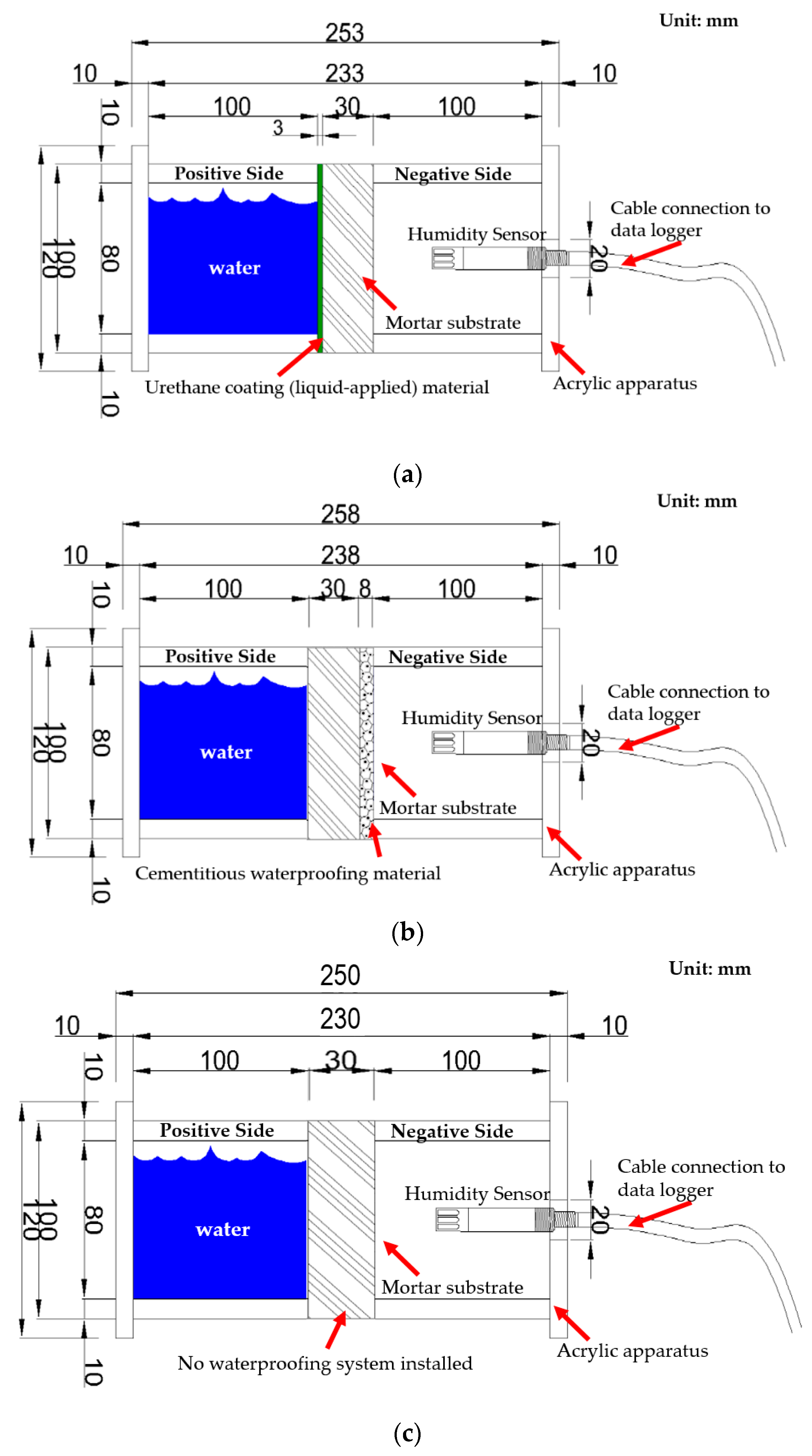
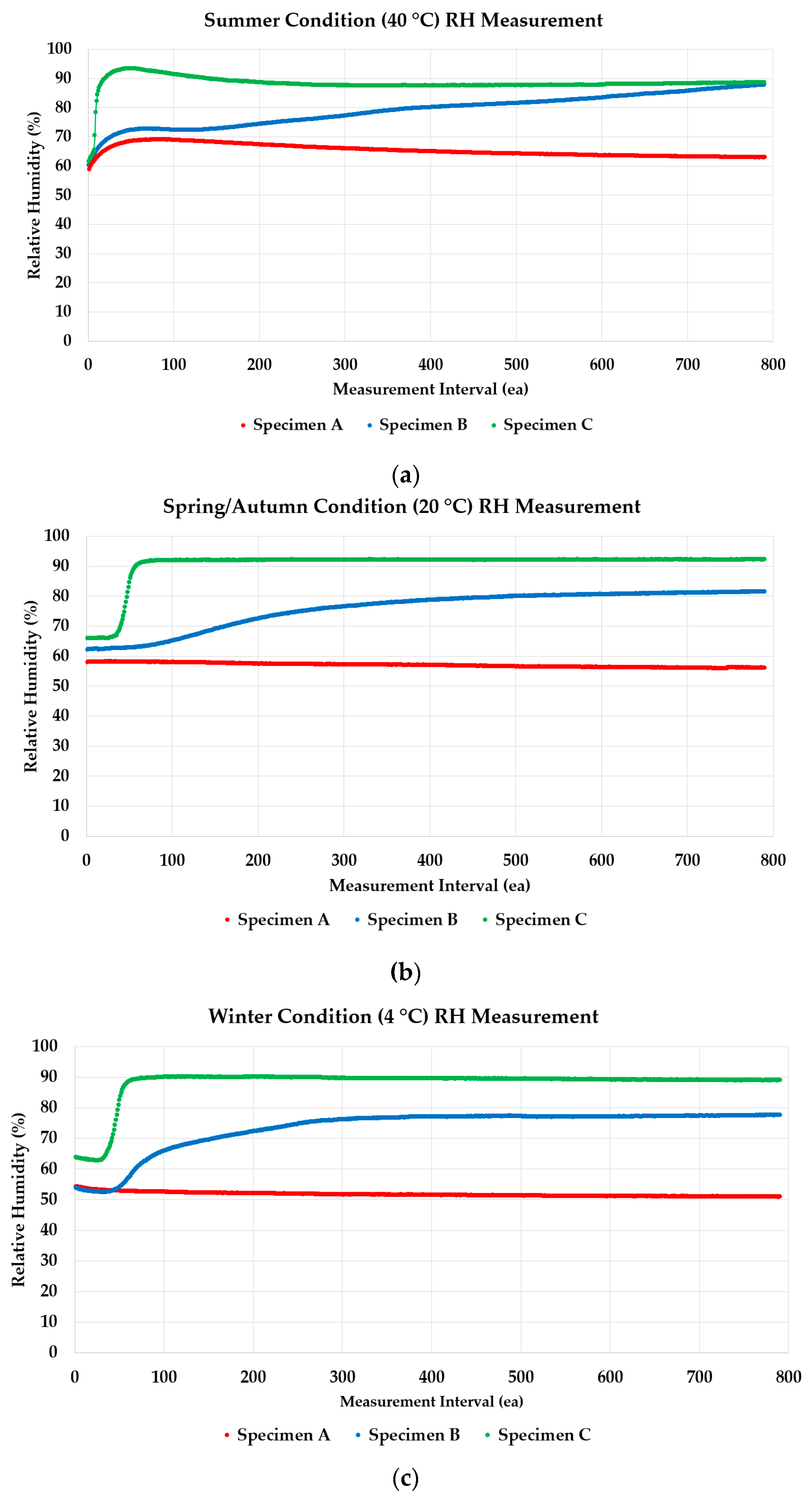

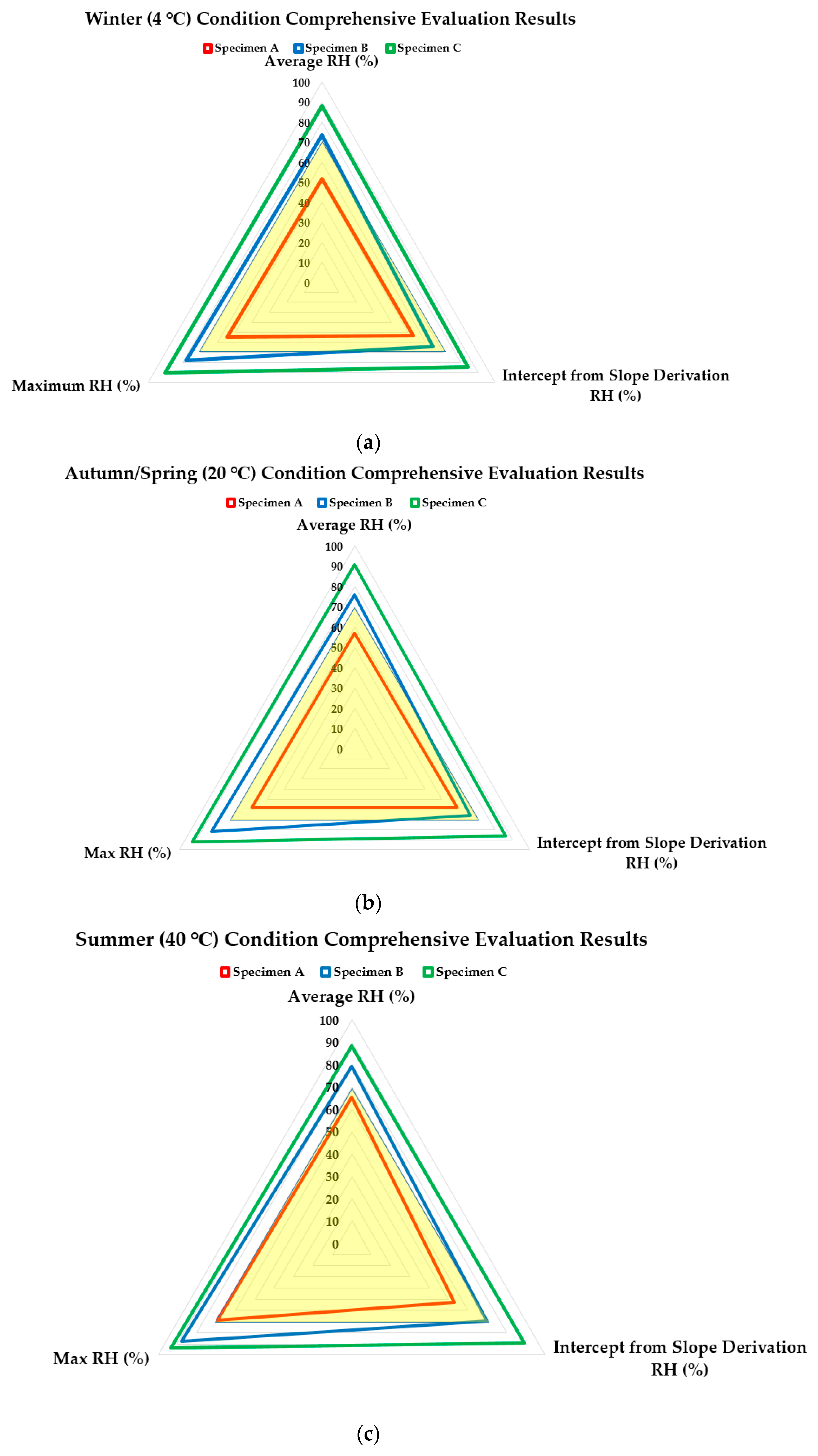
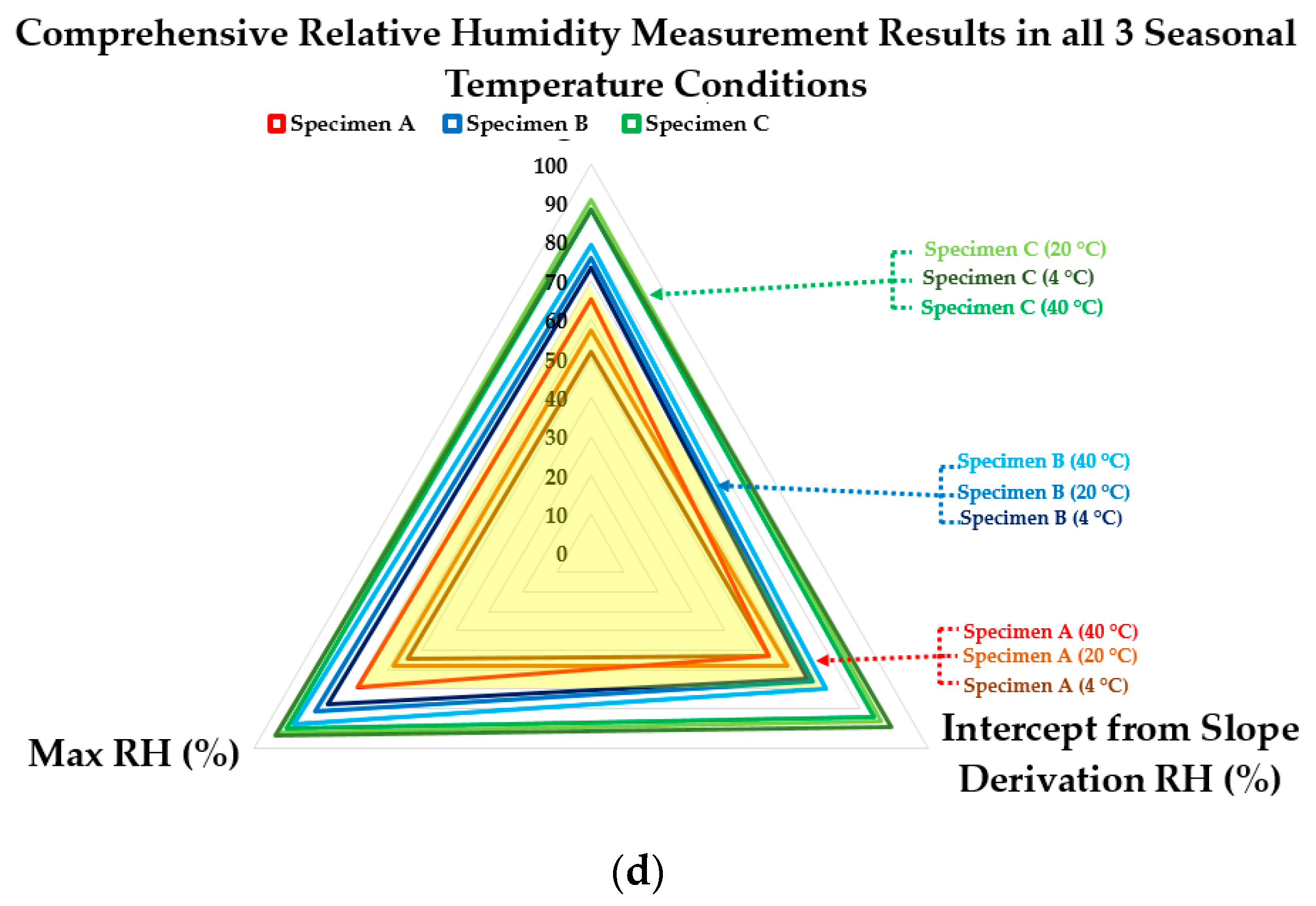
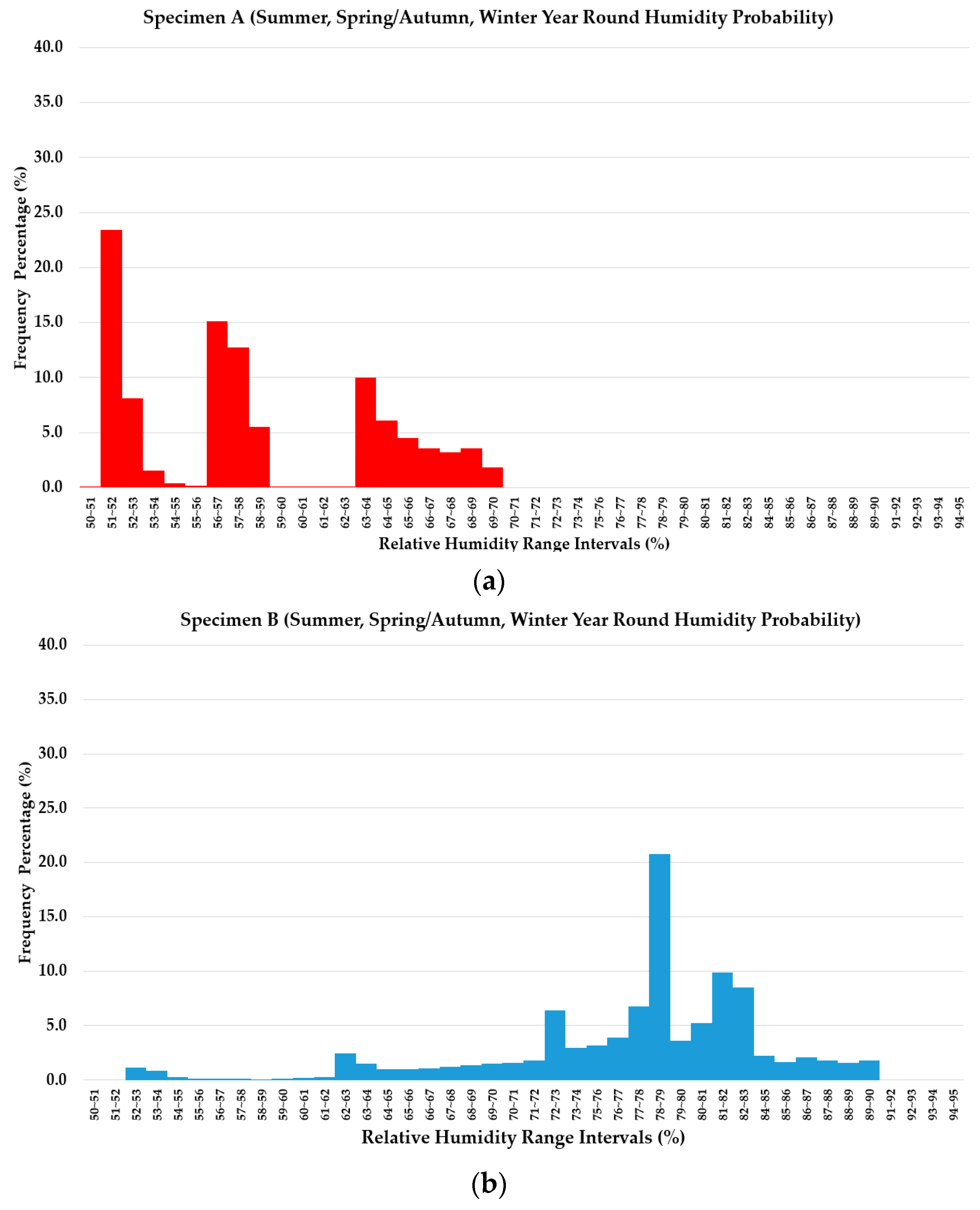
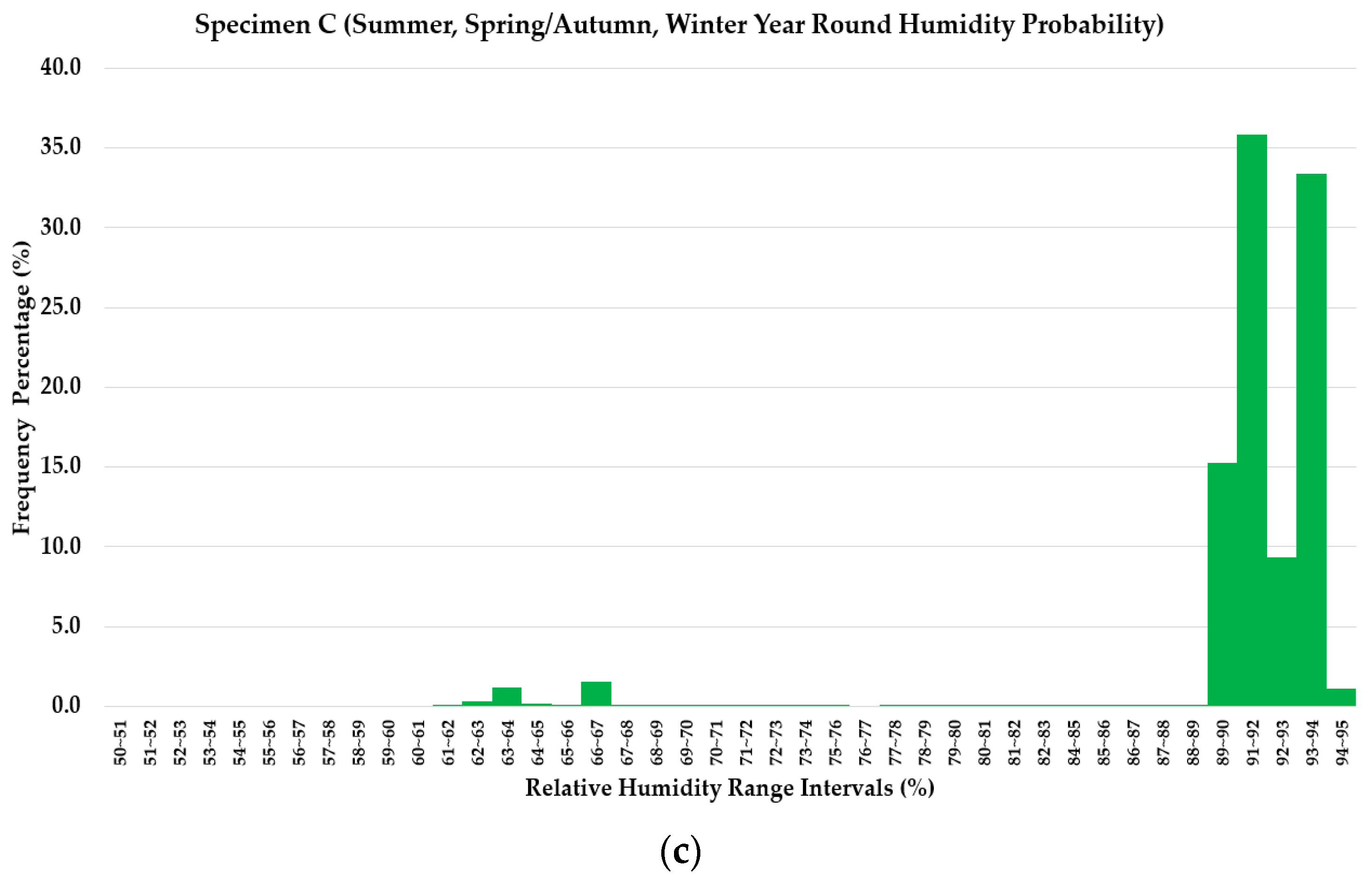
| Property | Standard | Criteria |
|---|---|---|
| Waterproofing Material Physical Properties for Bituminous and non-bituminous organic | ||
| Resistance to Hydrostatic Pressure | Test Method D5385 | No leaks at 103 kPa [15 psi] [34.65 ft head] or at the maximum hydrostatic pressure determined by the subsurface soil investigation per IBC para. 1802.2.3 |
| Resistance to Deterioration from Organisms and Substances in Contacting Soil | Test Method D7281 | Pass |
| Test Method E154 | <0.3 perms water vapor permeability | |
| Test Specification E1745 | Section 7 (using a 3 in. thick precast concrete paver in lieu of cast-in-place concrete). | |
| Adhesion to Substrate (Except for Grade 1, Class 2) | Test Method D7234 | >1518 kPa [220 psi] using a 50 mm [2 in.] dolly |
| Test Method D903 | 3 pli [535.8 gm/cm] | |
| Waterproofing Material Physical Properties for bituminous | ||
| Low Temperature Unrolling Type 1A | Test Method D5636 | No Cracking at 0°C [32 °F] |
| Crack Bridging | Test Method D5849 | 500 cycles select appropriate temperature for the weather conditions for which the membrane is applied. |
| Flexibility | Test Method D5683 | No Cracking |
| Water Absorption | Test Method D95 | <2 % by weight. Run 45 cycles of immersion in water at 23 °C and 50 °C [73 °F and 122 °F] for 24 h for start of test and after 45th cycle. |
| Waterproofing Material Physical Properties for Non-bituminous Organic | ||
| Water Absorption | Test Method D570 | <3 % by weight when tested per Section 7A |
| Test Method D471 | <3 % by weight when tested per Section 12 at 23 °C [73 °F] for 2998 h | |
| Linear Dimension Change (PVC only) | Specification D4551 | <5 % at 70 °C [158°F] 1 h per Test Method D1204 |
| Extensibility After Heat Aging | Test Method C1522 | 6.4 mm [1⁄4 in.] |
| Crack Bridging Ability | Test Method C1305 | No Cracking |
| Low Temperature Flexibility and Crack Bridging for Liquid-Applied Membranes | Test Method C1305 | Pass |
| Resistance of Plastics to Bacteria | Specification D4551 | No effect 12 of 12 samples pass |
| Resistance to Chemical Reagents | Practice D896 | No delamination, blistering, emulsification, or (undiluted deterioration 15 N/5P/5Potash) |
| Resistance to Petroleum | Test Methods E154 Section 14 | <0.3 perms |
| Item | Criteria |
|---|---|
| RH Range | 0~100% RH |
| Temperature Range | 0~100 °C, −20~80 °C |
| Precision at 23 °C | <±2% RH (10~99% RH) |
| Annual RH Stability | <±1% RH |
| RH reaction time | <10 s (up to 90%) |
| Signal Measurement | 0-1 VDC, 0-5 VDC, 0-10 VDC |
| Size | Length: 80 mm, Ȼ12 mm |
| Item | Support | Photo |
|---|---|---|
| DCV Precision | 0.004% / Year |  |
| Max. Scanning Speed | 250 channels / sec |
| Specimen Types | Seasonal Conditions | |||||
|---|---|---|---|---|---|---|
| Winter (4 °C) | Spring/Autumn (20 °C) | Summer (40 °C) | ||||
| Slope | Intercept (%) | Slope | Intercept (%) | Slope | Intercept (%) | |
| A | −2.7 × 10−3 | 52.862 | −3 × 10−3 | 58.269 | −7.2 × 10−3 | 68.327 |
| B | 2.32 × 10−2 | 64.248 | 2.48 × 10−2 | 66.079 | 2.33 × 10−2 | 69.857 |
| C | −9.7 × 10−3 | 84.311 | 1.12 × 10−2 | 86.268 | −1.8 × 10−3 | 89.083 |
| Specimen Types | Average, Intercept and Maximum of RH Measurement per Seasonal Conditioning | ||||||||
|---|---|---|---|---|---|---|---|---|---|
| Winter (4 °C) | Spring/Autumn (20 °C) | Summer (40 °C) | |||||||
| Avg. (%) | Intercept (%) | Max (%) | Avg. (%) | Intercept (%) | Max (%) | Avg. (%) | Intercept (%) | Max (%) | |
| A | 51.78 | 52.86 | 54.42 | 57.10 | 58.27 | 58.31 | 65.47 | 52.86 | 69.16 |
| B | 73.42 | 64.25 | 77.79 | 75.87 | 66.08 | 81.64 | 79.06 | 69.86 | 87.85 |
| C | 88.14 | 84.31 | 90.25 | 90.69 | 86.27 | 92.41 | 88.38 | 89.08 | 93.43 |
| Temp. Condition (°C) | Evaluation Results | ||||||||||||||
|---|---|---|---|---|---|---|---|---|---|---|---|---|---|---|---|
| Specimen A | Specimen B | Specimen C | |||||||||||||
| Avg. (%) | Intercept (%) | Max (%) | Slope | Range (%) | Avg. (%) | Intercept (%) | Max (%) | Slope | Range (%) | Avg. (%) | Intercept (%) | Max (%) | Slope | Range (%) | |
| Winter (4 °C) | 51.78 | 52.86 | 54.42 | −2.7 × 10−3 | 50~70 | 73.42 | 64.25 | 77.79 | −2.32 × 10−2 | 52~90 | 88.14 | 84.31 | 90.25 | 9.7 × 10−3 | 61~95 |
| Spring/Autumn (20 °C) | 57.10 | 58.27 | 58.31 | −3 × 10−3 | 75.87 | 66.08 | 81.64 | 2.48 × 10−2 | 90.69 | 86.27 | 92.41 | 1.12 × 10−3 | |||
| Summer (40 °C) | 65.47 | 52.86 | 69.16 | −7.2 × 10−3 | 79.06 | 69.86 | 87.85 | 2.33 × 10−2 | 88.38 | 89.08 | 93.43 | −1.8 × 10−3 | |||
© 2020 by the authors. Licensee MDPI, Basel, Switzerland. This article is an open access article distributed under the terms and conditions of the Creative Commons Attribution (CC BY) license (http://creativecommons.org/licenses/by/4.0/).
Share and Cite
An, K.-w.; Oh, K.-h.; Jiang, B.; He, X.; Oh, S.-k. Evaluation Method of Relative Humidity Changes in Below-Grade Concrete Structure Space Depending on Different Waterproofing Material and Installation Method. Materials 2020, 13, 742. https://doi.org/10.3390/ma13030742
An K-w, Oh K-h, Jiang B, He X, Oh S-k. Evaluation Method of Relative Humidity Changes in Below-Grade Concrete Structure Space Depending on Different Waterproofing Material and Installation Method. Materials. 2020; 13(3):742. https://doi.org/10.3390/ma13030742
Chicago/Turabian StyleAn, Ki-won, Kyu-hwan Oh, Bo Jiang, Xingyang He, and Sang-keun Oh. 2020. "Evaluation Method of Relative Humidity Changes in Below-Grade Concrete Structure Space Depending on Different Waterproofing Material and Installation Method" Materials 13, no. 3: 742. https://doi.org/10.3390/ma13030742
APA StyleAn, K.-w., Oh, K.-h., Jiang, B., He, X., & Oh, S.-k. (2020). Evaluation Method of Relative Humidity Changes in Below-Grade Concrete Structure Space Depending on Different Waterproofing Material and Installation Method. Materials, 13(3), 742. https://doi.org/10.3390/ma13030742





